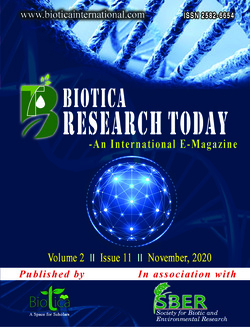
A New Invasive Insect Fall Army Worm, Spodoptera frugiperda (J. E. Smith) (Noctuidae: Lepidoptera) on Maize
Niranjanadevi Jeevanandham*
Dept. of Biotechnology, Agricultural College and Research Institute, Madurai, Tamil Nadu Agricultural University (TNAU), Coimbatore, Tamil Nadu (625 104), India
Velprabakaran S.
Dept. of Plant Breeding and Genetics, Agricultural College and Research Institute, Madurai, Tamil Nadu Agricultural University (TNAU), Coimbatore, Tamil Nadu (625 104), India
DOI: NIL
Keywords: Fall Armyworm, Life stages, Maize, Management
Abstract
The fall armyworm (FAW), Spodoptera frugiperda (J.E.Smith) (Noctuidae: Lepidoptera) is a serious polyphagous pest of voracious nature with a wide host range of approximately more than 100 recorded plant species in 27 families. This pest prefers plants from the Gramineae family including many economically important plants such as maize, millet, sorghum, sugarcane, rice, wheat, etc. There are reports on its infestation on other field crops like cowpea, groundnut, potato, soybean, cotton, etc. The fall armyworm was first officially reported in Nigeria in West Africa in 2016, and rapidly spread across 44 countries in sub-Saharan Africa. Yield reductions in maize due to feeding of the fall armyworm have been reported as high as 34% and some areas suffering up to 70% crop destruction. Fall armyworm causes significant yield losses if not well managed. It has several generations per year and the moth can fly up to 100 km per night.
Downloads
not found
Reference
Dew, J. A., 1913. Fall armyworm. J. Econ. Entomol, 6:361-366.
Luginbill, P., 1928. The fall armyworm. USDA Tech. Bull. No. 34.
Oliver, A.D., Chapin, J.B., 1981. Biology and illustrated key for the identification of twenty species of economically important noctuid pests. Louisiana Agricultural Experiment Station Bulletin No. 733.
